A Causal Long Short-Term Memory Sequence to Sequence Model for TEC Prediction Using GNSS Observations
Abstract
1. Introduction
1.1. Related Work
1.2. Our Contribution
- All-in-one modeling: Usually, existing models for timeseries prediction pertain to univariate timeseries, thus predicting TEC timeseries per satellite implies using a number of models equal to the number of satellites being tracked. On the contrary, our model uses at the same time all the satellites, thus forming a generic model.
- Sequential modeling: Most existing models use a fixed data duration as input, whereas the TEC sequences per satellite, are not all of the same length, as this depends on the time duration that a satellite is visible from a ground station. LSTMs can successfully deal with data sequences of varying lengths.
- Long term modeling: LSTMs with their internal memory, remember previous information that reflects the past behavior of the ionosphere and find patterns across time for accurate prediction of the next guess–estimates, making them ideal for time series forecasting.
2. LSTM Regression Model for Ionospheric Correction
2.1. Problem Formulation
2.2. Unidirectional Long-Term Recurrent Regression
2.3. The Proposed LSTM Regression Model for TEC Prediction
3. PPP Processing Strategy
4. Results and Discussion
4.1. Performance Comparison among Different Methods
4.2. Comparison among Different Stations and Time Periods
4.3. Comparison between Different Satellites
4.4. Comparison among Different Ionosphere Models
5. Conclusions
Author Contributions
Funding
Conflicts of Interest
Abbreviations
| AR | Autoregressive |
| ARMA | Autoregressive Moving Average |
| CAS | Chinese Academy of Sciences |
| CODE | Centre for Orbit Determination in Europe |
| CNN | Convolutional Neural Networks |
| DCB | Differential Code Biases |
| COSPAR | Committee On Space Research |
| DOY | Day of Year |
| ESA | European Space Agency |
| GIM | Global Ionosphere Maps |
| GNSS | Global Navigation Satellite System |
| IAAC | Ionosphere Associate Analysis Center |
| IGG | Institute of Geodesy and Geophysics |
| IGS | International GNSS Service |
| IONEX | IONospheric EXchange |
| JPL | Jet Propulsion Laboratory |
| LSTM | Long Short-Term Memory |
| MGEX | Multi-GNSS Experiment |
| RBF | Radial Basic Function |
| RNN | Recurrent neural network |
| STEC | Slant Total Electron Content |
| TEC | Total electron content |
| UPC | Polytechnic University of Catalonia |
| URSI | Union of Radio Science |
| VBLI | Very Long Baseline Interferometry |
| VTEC | Vertical Total Electron Content |
References
- Hoque, M.M.; Jakowski, N. Higher Order Ionospheric Effects in Precise GNSS Positioning. J. Geodesy 2007, 81, 259–268. [Google Scholar] [CrossRef]
- Klobuchar, J. Ionospheric time-delay algorithm for single frequency GPS users. IEEE Trans. Aerosp. Electron. Syst. 1987, 23, 325–332. [Google Scholar] [CrossRef]
- Nava, B.; Coïsson, P.; Radicella, S. A New Version of the NeQuick Ionosphere Electron Density Model. J. Atmos. Solar-Terrestrial Phys. Ionos. Effects Telecommun. 2008, 15, 1856–1862. [Google Scholar] [CrossRef]
- Bakker, P.; Christian, T. Real-Time Multi-GNSS Single-Frequency Precise Point Positioning. GPS Solut. 2017, 4, 1791–1803. [Google Scholar] [CrossRef]
- Hochreiter, S.; Jürgen, S. Long Short-Term Memory. Neural Comput. 1997, 8, 1735–1780. [Google Scholar] [CrossRef]
- Wang, C.; Xin, S.; Liu, X.; Shi, C.; Fan, L. Prediction of global ionospheric VTEC maps using an adaptive autoregressive model. Earth Planets Space 2018, 70, 18. [Google Scholar] [CrossRef]
- Mandrikova, O.V.; Glushkova, N.V.; Zhivet’ev, I.V. Modeling and analysis of ionospheric parameters by a combination of wavelet transform and autoregression models. Geomagn. Aeron. 2014, 54, 593–600. [Google Scholar] [CrossRef]
- Voulodimos, A.; Doulamis, N.; Doulamis, A.; Protopapadakis, E. Deep Learning for Computer Vision: A Brief Review. Comput. Intell. Neurosci. 2018, 2018, 7068349. [Google Scholar] [CrossRef]
- Protopapadakis, E.; Voulodimos, A.; Doulamis, A.; Doulamis, N.; Dres, D.; Bimpas, M. Stacked Autoencoders for Outlier Detection in Over-the-Horizon Radar Signals. Comput. Intell. Neurosci. 2017, 2017, 5891417. [Google Scholar] [CrossRef]
- Greff, K.; Srivastava, R.K.; Koutník, J.; Steunebrink, B.R.; Schmidhuber, J. LSTM: A Search Space Odyssey. IEEE Trans. Neural Netw. Learn. Syst. 2017, 10, 2222–2232. [Google Scholar] [CrossRef]
- Jiang, H.; Liu, J.; Wang, Z.; An, J.; Ou, J.; Liu, S.; Wang, N. Assessment of spatial and temporal TEC variations derived from ionospheric models over the polar regions. J. Geod. 2019, 93, 455. [Google Scholar] [CrossRef]
- An, X.; Meng, X.; Chen, H.; Jiang, W.; Xi, R.; Chen, Q. Modelling Global Ionosphere Based on Multi-Frequency, Multi-Constellation GNSS Observations and IRI Model. Remote Sens. 2020, 12, 439. [Google Scholar] [CrossRef]
- Wang, J.; Huang, G.; Zhou, P.; Yang, Y.; Zhang, Q.; Gao, Y. Advantages of Uncombined Precise Point Positioning with Fixed Ambiguity Resolution for Slant Total Electron Content (STEC) and Differential Code Bias (DCB) Estimation. Remote Sens. 2020, 12, 304. [Google Scholar] [CrossRef]
- Krypiak-Gregorczyk, A.; Wielgosz, P.; Borkowski, A. Ionosphere Model for European Region Based on Multi-GNSS Data and TPS Interpolation. Remote Sens. 2017, 9, 1221. [Google Scholar] [CrossRef]
- Ren, X.; Zhang, X.; Xie, W.; Zhang, K.; Yuan, Y.; Li, X. Global Ionospheric Modelling using Multi-GNSS: BeiDou, Galileo, GLONASS and GPS. Sci. Rep. 2007, 6, 33499. [Google Scholar] [CrossRef] [PubMed]
- Øvstedal, O. Absolute Positioning with Single-Frequency GPS Receivers. GPS Solut. 2002, 5, 33–44. [Google Scholar] [CrossRef]
- Alizadeh, M.M.; Wijaya, D.D.; Hobiger, T.; Weber, R.; Schuh, H. Ionospheric Effects on Microwave Signals. In Atmospheric Effects in Space Geodesy; Springer Atmospheric Sciences; Böhm, J., Schuh, H., Eds.; Springer: Berlin/Heidelberg, Germany, 2013. [Google Scholar]
- Ou, M.; Zhang, H.; Liu, D.; Yu, X.; Zhen, W. GIM-ingested NeQuick model applied for GPS single frequency ionospheric correction in China. ISAPE 2012 2012, 652–655. [Google Scholar] [CrossRef]
- Feng, J.; Han, B.; Zhao, Z.; Wang, Z. A New Global Total Electron Content Empirical Model. Remote Sens. 2019, 11, 706. [Google Scholar] [CrossRef]
- Zhang, Z.; Shuguo, P.; Chengfa, G.; Tao, Z.; Wang, G. Support Vector Machine for Regional Ionospheric Delay Modeling. Sensors 2019, 19, 2947. [Google Scholar] [CrossRef]
- Huang, Z.; Yuan, H. Ionospheric Single-Station TEC Short-Term Forecast Using RBF Neural Network. Radio Sci. 2014, 49, 283–292. [Google Scholar] [CrossRef]
- Yilmaz, A.; Akdogan, K.E.; Gurun, M. Regional TEC Mapping Using Neural Networks. Radio Sci. 2009, 44, 1–16. [Google Scholar] [CrossRef]
- Su, K.; Jin, S.; Hoque, M.M. Evaluation of Ionospheric Delay Effects on Multi-GNSS Positioning Performance. Remote Sens. 2019, 11, 171. [Google Scholar] [CrossRef]
- Bosco, H.J.; McKinnell, L.; Cilliers, P.J.; Opperman, B. Application of Neural Networks to South African GPS TEC Modelling. Adv. Space Res. 2009, 43, 1711–1720. [Google Scholar]
- Boulch, A.; Cherrier, N.; Castaings, T. Ionospheric Activity Prediction Using Convolutional Recurrent Neural Networks. arXiv 2018, arXiv:1810.13273. [Google Scholar]
- Sun, W.; Xu, L.; Huang, X.; Zhang, W.; Yuan, T.; Yan, Y. Bidirectional LSTM for ionospheric vertical Total Electron Content (TEC) forecasting. In Proceedings of the 2017 IEEE Visual Communications and Image Processing (VCIP), St. Petersburg, FL, USA, 10–13 December 2017; pp. 1–4. [Google Scholar]
- Sundermeyer, M.; Schlüter, R.; Ney, H. LSTM Neural Networks for Language Modeling. In Proceedings of the INTERSPEECH, Portland, OR, USA, 9–13 September 2012. [Google Scholar]
- Graves, A.; Mohamed, A.; Hinton, G. Speech Recognition with Deep Recurrent Neural Networks. In Proceedings of the IEEE International Conference on Acoustics, Speech and Signal Processing, Vancouver, BC, Canada, 26–31 May 2013; pp. 6645–6649. [Google Scholar]
- Ullah, A.; Ahmad, J.; Muhammad, K.; Sajjad, M.; Baik, S.W. Action Recognition in Video Sequences Using Deep Bi-Directional LSTM With CNN Features. IEEE Access 2018, 6, 1155–1166. [Google Scholar] [CrossRef]
- Graves, A. Generating Sequences With Recurrent Neural Networks. arXiv 2014, arXiv:1308.0850. [Google Scholar]
- Zhou, F.; Dong, D.; Li, W.; Jiang, X.; Wickert, J.; Schuh, H. GAMP: An open-source software of multi-GNSS precise point positioning using undifferenced and uncombined observations. Gps Solut. 2018, 22, 33. [Google Scholar] [CrossRef]
- Xiang, Y.; Gao, Y.; Li, Y. Ionospheric stec and vtec constraints for fast ppp. In China Satellite Navigation Conference; Springer: Singapore, 2017; pp. 257–269. [Google Scholar]
- Komjathy, A.; Langley, R.B. An assessment of predicted and measured ionospheric total electron content using a regional GPS network. In Proceedings of the ION National Technical Meeting, Santa Monica, CA, 22–24 January 1996; pp. 615–624. [Google Scholar]
- Abdelazeem, M.; Çelik, R.N.; El-Rabbany, A. An efficient regional ionospheric model using combined GPS/BeiDou observations. J. Spat. Sci. 2017, 62, 323–335. [Google Scholar] [CrossRef]
- Rho, H.; Langley, R.B.; Komjathy, A. An enhanced UNB ionospheric modeling technique for SBAS: The quadratic approach. In Proceedings of the 17th International Technical Meeting of the Satellite Division of the Institute of Navigation, Long Beach, CA, USA, 21–24 September 2004; pp. 354–365. [Google Scholar]
- Brunini, C.; Azpilicueta, F. GPS slant total electron content accuracy using the single layer model under different geomagnetic regions and ionospheric conditions. J. Geod. 2010, 84, 293–304. [Google Scholar] [CrossRef]
- Xiang, Y.; Gao, Y. An Enhanced Mapping Function with Ionospheric Varying Height. Remote Sens. 2019, 11, 1497. [Google Scholar] [CrossRef]
- Doulamis, A.D.; Doulamis, N.D.; Kollias, S.D. An Adaptable Neural-Network Model for Recursive Nonlinear Traffic Prediction and Modeling of MPEG Video Sources. IEEE Trans. Neural Netw. 2003, 14, 150–166. [Google Scholar] [CrossRef]
- Gers, F.A.; Schmidhuber, J.; Cummins, F. Learning to Forget: Continual Prediction with LSTM. In 1999 Ninth International Conference on Artificial Neural Networks ICANN; IET: London, UK, 1999. [Google Scholar]
- Montenbruck, O.; Steigenberger, P.; Prange, L.; Deng, Z.; Zhao, Q.; Perosanz, F.; Romero, I.; Noll, C.; Stürze, A.; Weber, G. The Multi-GNSS Experiment (MGEX) of the International GNSS Service (IGS)—Achievements, Prospects and Challenges. Adv. Space Res. 2017, 59, 1671. [Google Scholar] [CrossRef]
- Kaselimi, M.; Doulamis, N.; Delikaraoglou, D.; Protopapadakis, E. GNSSGET and GNSSPLOT Platforms–Matlab GUIs for Retrieving GNSS Products and Visualizing GNSS Solutions. In Proceedings of the 13th International Joint Conference on Computer Vision, Imaging and Computer Graphics Theory and Applications (VISIGRAPP 2018)-VISAPP, Funchal, Madeira, Portugal, 27–29 January 2018; Volume 5, pp. 626–633. [Google Scholar]
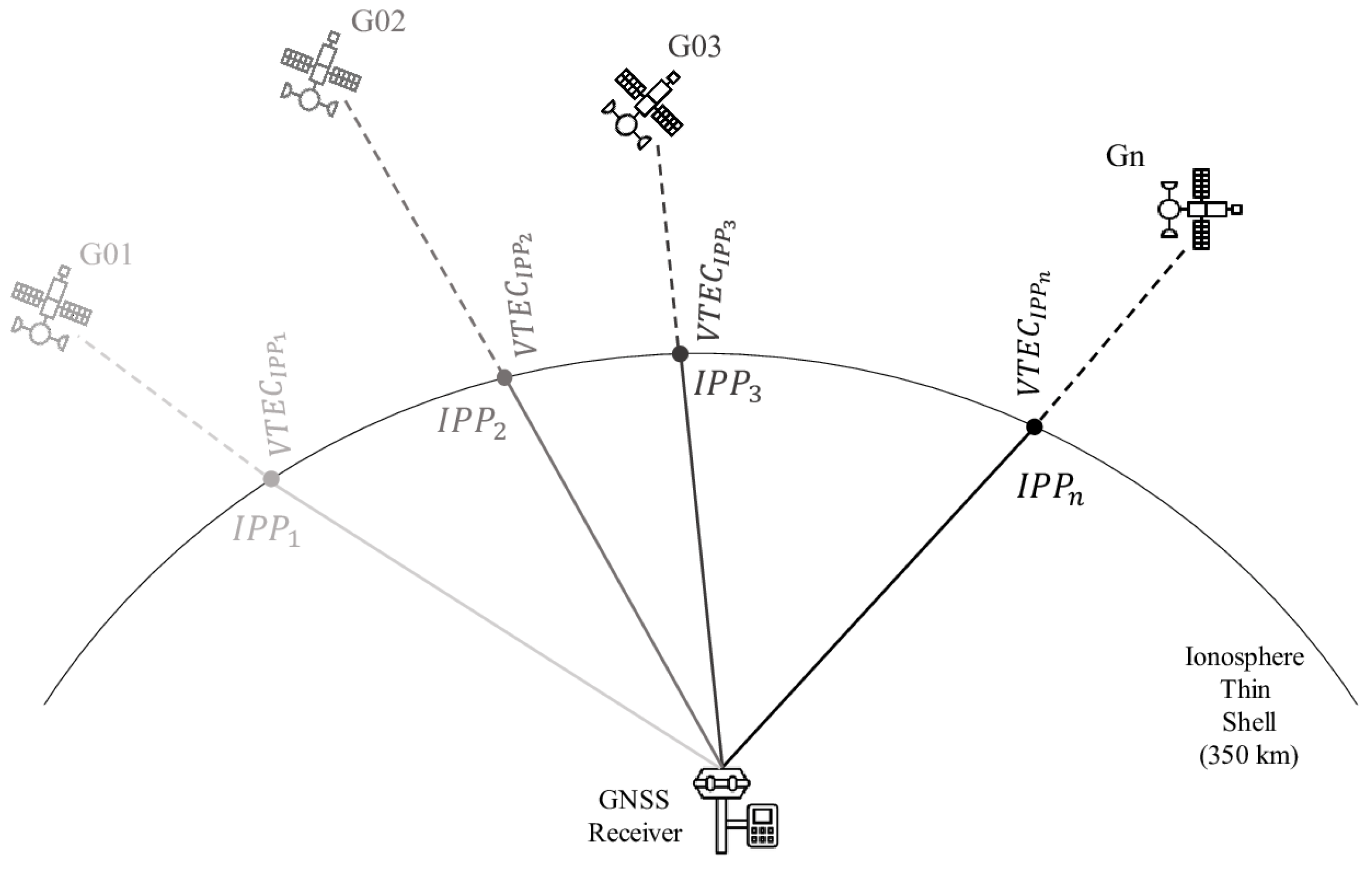

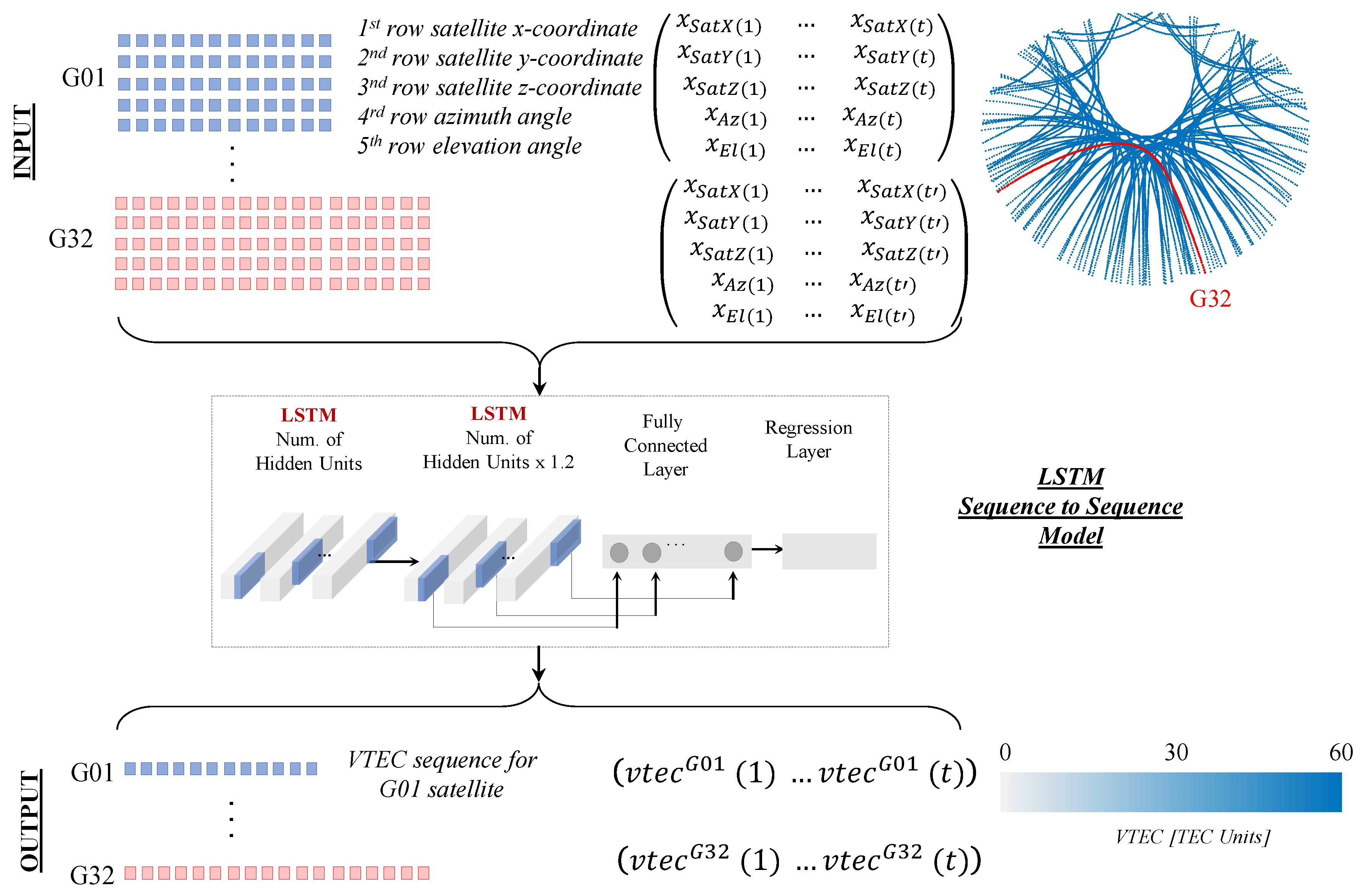
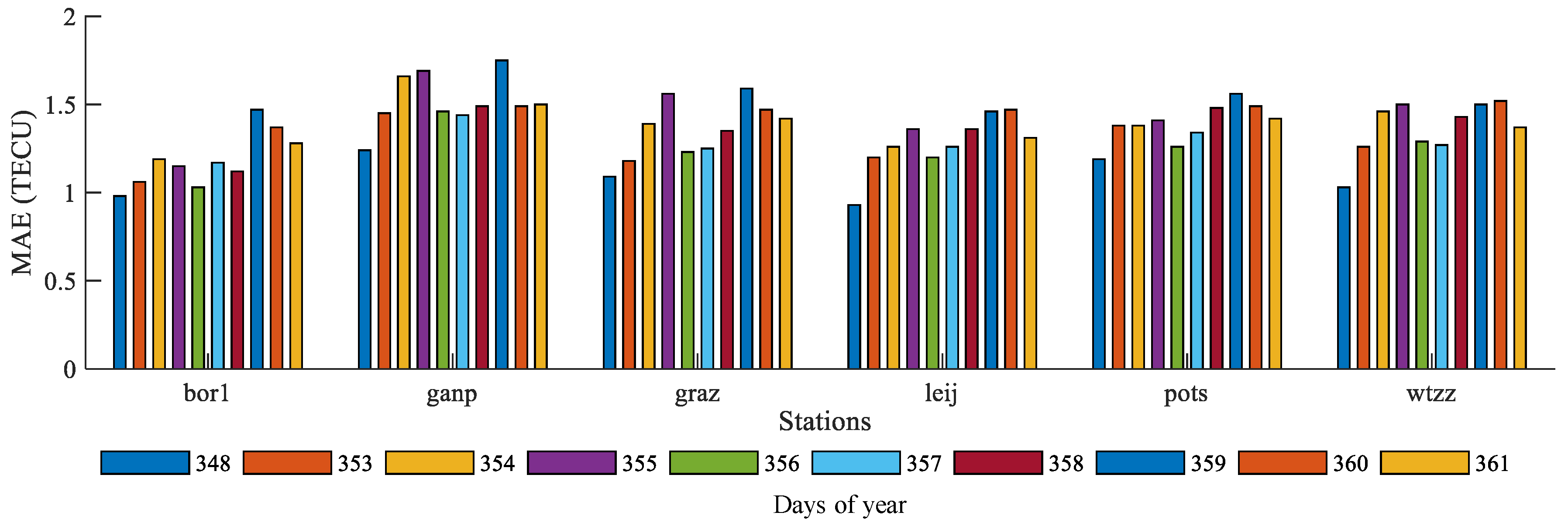
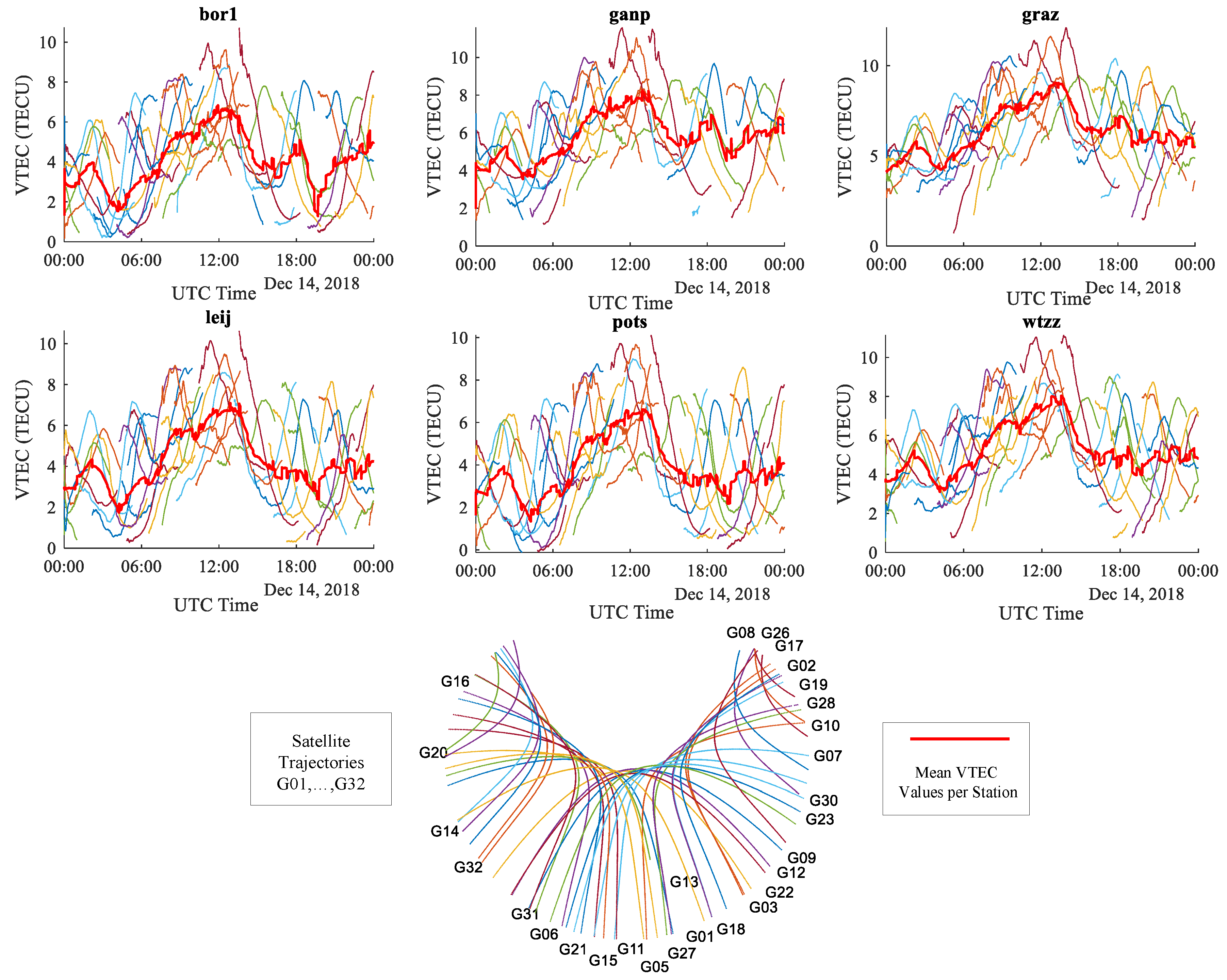
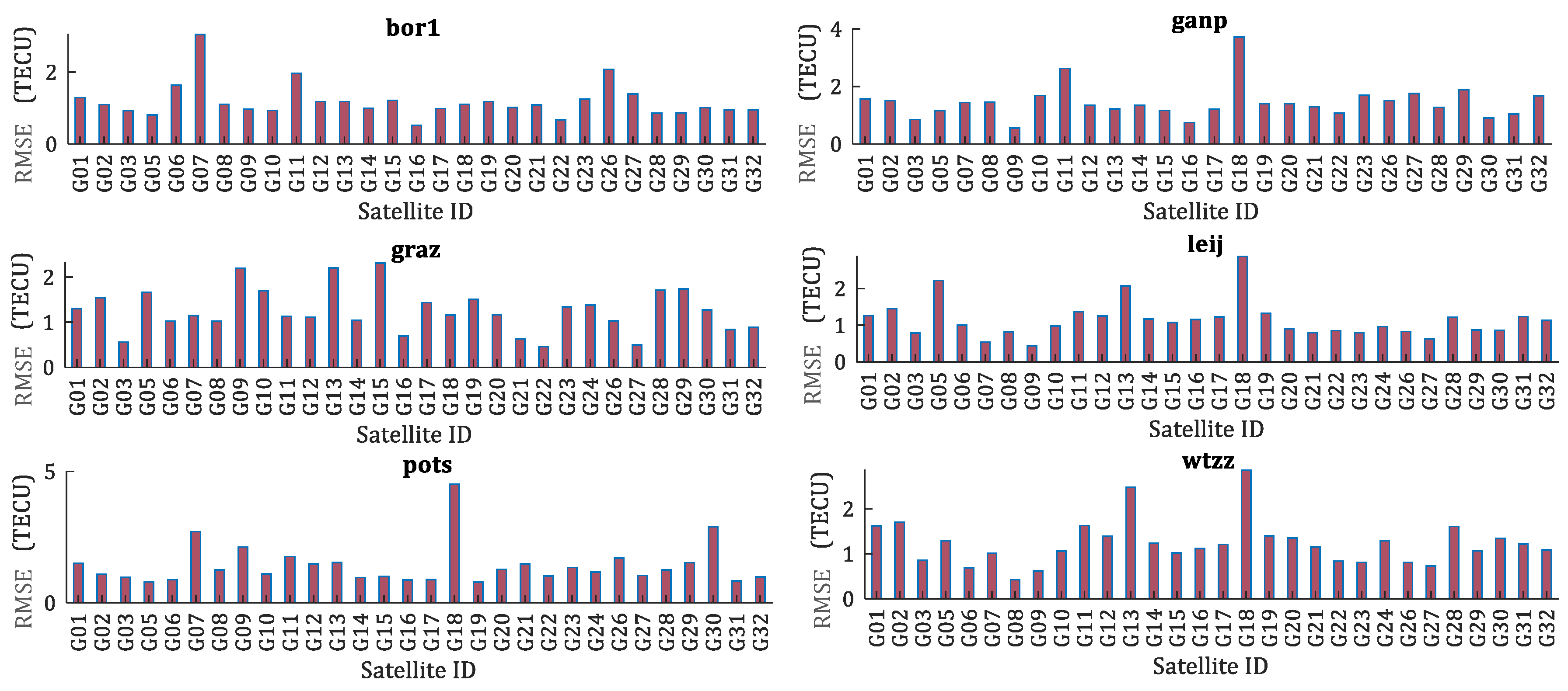

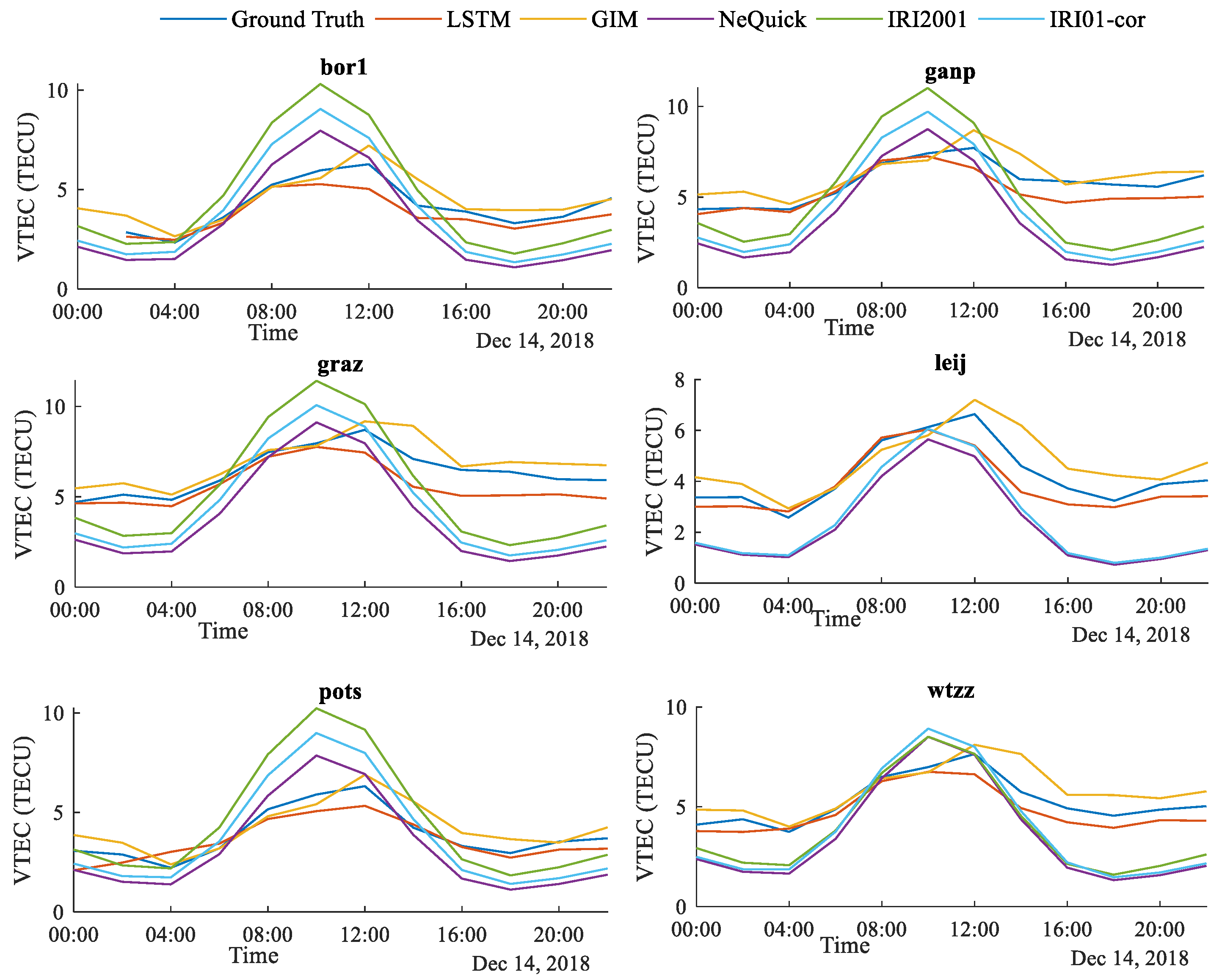

| Stations | Latitude° | Longitude° | Country |
|---|---|---|---|
| bor1 | 52.276958352 | 17.073459989 | Poland |
| ganp | 49.034715044 | 20.322939096 | Slovakia |
| graz | 47.067131595 | 15.493484133 | Austria |
| leij | 51.353981980 | 12.374101226 | Germany |
| pots | 52.379299109 | 13.066095112 | Germany |
| wtzz | 49.144213977 | 12.878907414 | Germany |
| Options | Settings |
|---|---|
| Constellation | GPS |
| Positioning mode | static PPP |
| Frequencies | L1, L2 |
| Sampling rate | 30 s |
| Elevation mask | |
| Differential code bias (DCB) | Correct using MGEX DCB products for PPP |
| Tropospheric zenith wet delay | initial model + estimated (random walk process) |
| Receiver and Satellite antenna | corrected with igs14.atx |
| Phase wind-up | Corrected |
| Sagnac effect, relativistic effect | Corrected with IGS absolute |
| Station reference coordinates | IGS SINEX solutions |
| Receiver r | bor1 | ganp | graz | |||||||||
| Metric | ||||||||||||
| LSTM | 0.98 | 0.04 | 3.05 | 1.18 | 1.24 | 0.02 | 2.88 | 1.45 | 1.09 | 0.03 | 2.76 | 1.26 |
| ARMA | 1.41 | 0.01 | 3.76 | 1.76 | 1.63 | 0.02 | 3.94 | 2.03 | 1.70 | 0.04 | 3.85 | 2.03 |
| AR | 1.91 | 0.04 | 4.40 | 2.29 | 1.85 | 0.02 | 4.28 | 2.25 | 1.77 | 0.02 | 3.98 | 2.13 |
| Receiver r | leij | pots | wtzz | |||||||||
| Metric | ||||||||||||
| LSTM | 0.93 | 0.02 | 2.66 | 1.14 | 1.19 | 0.01 | 3.52 | 1.42 | 1.03 | 0.04 | 2.68 | 1.23 |
| ARMA | 1.63 | 0.01 | 3.96 | 1.98 | 1.71 | 0.01 | 4.12 | 2.07 | 1.54 | 0.01 | 3.78 | 1.91 |
| AR | 1.87 | 0.01 | 4.22 | 2.22 | 1.94 | 0.01 | 4.33 | 2.30 | 1.79 | 0.01 | 4.10 | 2.15 |
| Elapsed Time (s) | |||
|---|---|---|---|
| Stations | LSTM | ARMA | AR |
| bor1 | 719 | 55 | 1 |
| graz | 559 | 58 | 3 |
| wtzz | 600 | 53 | 1 |
© 2020 by the authors. Licensee MDPI, Basel, Switzerland. This article is an open access article distributed under the terms and conditions of the Creative Commons Attribution (CC BY) license (http://creativecommons.org/licenses/by/4.0/).
Share and Cite
Kaselimi, M.; Voulodimos, A.; Doulamis, N.; Doulamis, A.; Delikaraoglou, D. A Causal Long Short-Term Memory Sequence to Sequence Model for TEC Prediction Using GNSS Observations. Remote Sens. 2020, 12, 1354. https://doi.org/10.3390/rs12091354
Kaselimi M, Voulodimos A, Doulamis N, Doulamis A, Delikaraoglou D. A Causal Long Short-Term Memory Sequence to Sequence Model for TEC Prediction Using GNSS Observations. Remote Sensing. 2020; 12(9):1354. https://doi.org/10.3390/rs12091354
Chicago/Turabian StyleKaselimi, Maria, Athanasios Voulodimos, Nikolaos Doulamis, Anastasios Doulamis, and Demitris Delikaraoglou. 2020. "A Causal Long Short-Term Memory Sequence to Sequence Model for TEC Prediction Using GNSS Observations" Remote Sensing 12, no. 9: 1354. https://doi.org/10.3390/rs12091354
APA StyleKaselimi, M., Voulodimos, A., Doulamis, N., Doulamis, A., & Delikaraoglou, D. (2020). A Causal Long Short-Term Memory Sequence to Sequence Model for TEC Prediction Using GNSS Observations. Remote Sensing, 12(9), 1354. https://doi.org/10.3390/rs12091354









